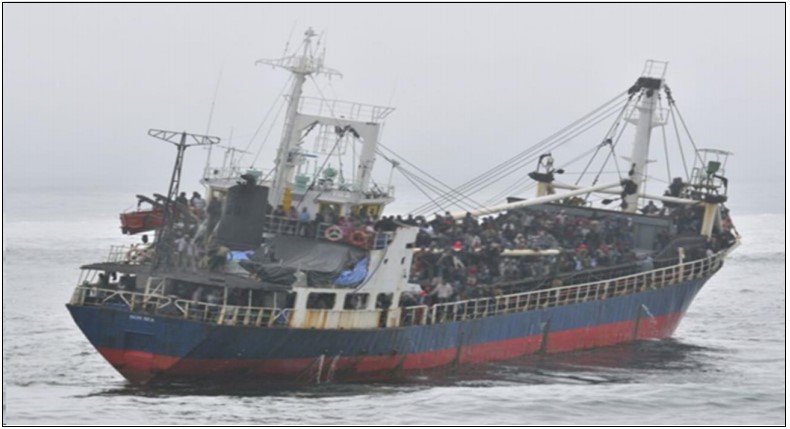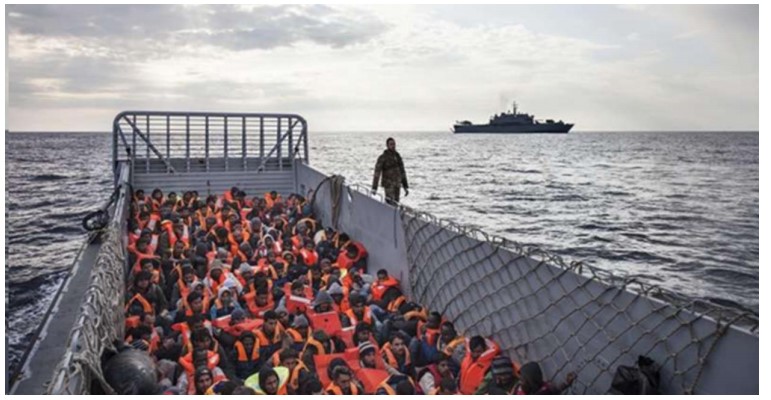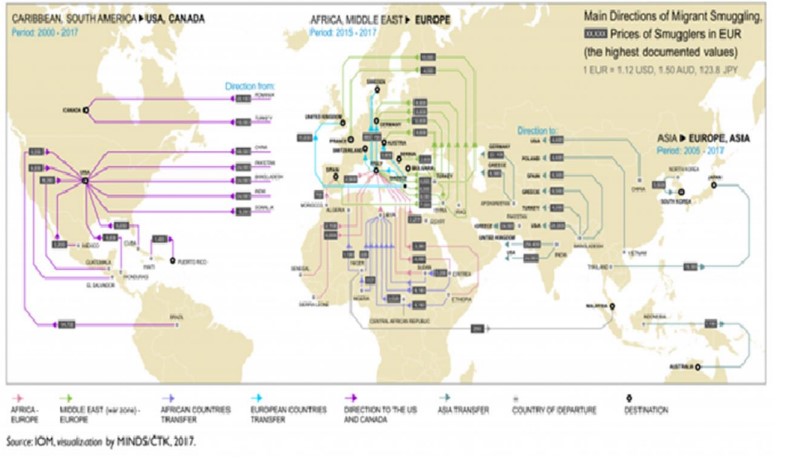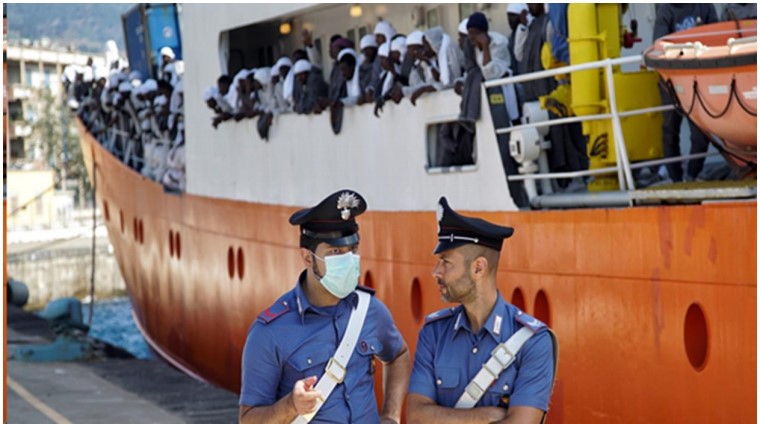
Introduction: Human Trafficking
rticle 3, paragraph (a) of the Protocol to Prevent, Suppress and Punish Trafficking in Persons defines Trafficking in Persons as ―the recruitment, transportation, transfer, harbouring or receipt of persons, by means of the threat or use of force or other forms of coercion, of abduction, of fraud, of deception, of the abuse of power or of a position of vulnerability or of the giving or receiving of payments or benefits to achieve the consent of a person having control over another person, for the purpose of exploitation. Exploitation shall include, at a minimum, the exploitation of the prostitution of others or other forms of sexual exploitation, forced labour or services, slavery or practices similar to slavery, servitude or the removal of organs.”
Human trafficking occurs not only domestically but transnationally as well. It is also considered to be the fasted growing activities of transnational criminal organizations and has resulted in a‖32 billion dollars‖ annual profit, with no real cost.[2] [3] Human trafficking is considered to be highly profitable, hard to detect and the law as such is lacking, thus making the punishment incurred worth the crime for some.
The most common victims of human trafficking are women and children from poor, rural areas in developing countries. There continue to be many forms of trafficking, some of them being];
1. Trafficking for forced labour – Victims mostly originate from developing countries. They are held in conditions similar to that of slavery in various jobs.
2. Trafficking in women for sexual exploitation – This certain trafficking affects every region of the world, that is vulnerable, regardless of it being a developed or developing country. Victims are usually taken under the false pretense of decent employment to achieve a better life.
3. Commercial sexual exploitation of children in tourism – Mostly prominent in Asia but has now found a hold in Africa and South America as well.
4. Trafficking for tissue, cells and organs – This trafficking is a rapidly growing field as it is very lucrative. This is due to the fact that in most countries the waiting list for transplants is very long.
Trafficking at sea involves seafarers and fishers in the context of at-sea activities, i.e. it includes fishing, transporting and fish processing, while on vessels, rafts, fishing platforms, or otherwise offshore. This does not include any sort of shore-based operations like packaging, and any kind of port-based work.

Inadequate investigation and examination has been done for trafficking at sea as a standalone subject, be that as it may, there keeps on being an assemblage of writing on work and labour issues that fishers and seafarers might face, involving any kind of violation, infringement and exploitation they may confront. This group of learning, while not unequivocally about trafficking, can reveal insight into various parts of the seafaring and fishing sectors, including how these may converge with human trafficking and where human trafficking has gone unrecognized in this labour sector. Additionally, there have been an increase in recent reports tackling exploitation, human rights and even human trafficking. However, it stands to say that there is dearth in the information available regarding the issue of trafficking of and by seafarers and fishers
Human Trafficking and Human Smuggling
In this time and age it has also become important to differentiate between human trafficking and human or migrant smuggling. Unlike human trafficking where the individual has not given any consent and is exploited, human smuggling occurs when a person voluntarily enters into an agreement with a smuggler to gain illegal entry into a foreign country and is moved across an international border. It is defined in the Protocol against the Smuggling of Migrants by Land, Sea, and Air (Migrant Smuggling Protocol), supplementing the United Nations Convention against Transnational Organized Crime. Nevertheless, we cannot ignore the fact that people who are smuggled can be extremely vulnerable to human trafficking, abuse, and other crimes, as they are illegally present in the country of destination and often owe large debts to their smugglers. Technically speaking, the smuggler and the migrant‘s relationship should come to an end as soon as the person has arrived in the destination country.[5] Nonetheless, evidence points out to something altogether different where the illegal migrants are continued to be exploited, this is done through constant threats and demands for additional fees made by the smugglers. There have been cases where migrants are forced to work for years on end in the illegal labour market to pay off the resultant debt due to their transportation. This is where both human trafficking and people smuggling start overlapping.]
Human trafficking and human smuggling are two distinct phenomena, and yet they are interlinked and partly overlapping. An important difference between both of these would be that smuggling is more of a crime that violates the national and international borders in place as compared to trafficking which is a crime which primarily violates the fundamental rights of a person.[7] The state will provide support and assistance to the victims of trafficking whereas it generally does not recognise the smuggled migrants as victims of crime.
Despite all of this, the distinction between both of these crimes is not that easy to discern and authorities find themselves challenged, this includes ferry personnel
Circumstances have indicated that smuggled migrants may become victims of trafficking, and that traffickers are also found to be acting as smugglers and use the same routes for both trafficking and smugglings. Trafficking in persons and the smuggling of migrants are part of a continuum of a migration process and the person who is smuggled one day may be a trafficked person the next.]
It stands to say that even if initial consent has been, it becomes legally irrelevant as the trafficker starts using threats, coercion, deception or fraud in order to exploit the victim.[10] The recent increase in migration into Europe has shown that the categories are not as clear cut e.g. in situations where female migrants are forced to provide sexual services to smugglers, or when migrants are forced to compensate the costs of smuggling through labour.
Main Sea Routes for Human Smuggling and Human Trafficking
“Modern slavery doesn‟t happen only in warzones. It exists in areas of both darkness and plain sight of people all over the world – even at sea … there are many, many stories … where unscrupulous fishermen use the isolation of the sea to hide their crimes … And the reasons aren‟t hard to figure out. When criminals are able to turn a profit in an illegal fishing market, they‟ll go after as many fish as possible. …the more labor they have on board, the larger their catches will be. The economic incentives are there, which is precisely why illegal, unregulated, and unreported fishing practices have grown into a $20 billion a year industry.‖ John Kerry ( Former US Secretary Of State), remark at the 2016 Trafficking in Persons Report Ceremony
Migrant Smuggling in the World: A Global Story

From Africa to Europe
At present, there are two focal routes of smuggling from Africa to Europe, crossing the Mediterranean between Libya and Italy (the central Mediterranean route) and between Morocco and Spain (the Western Mediterranean route). Recently, a growing number of Africans have been detected to be transiting via Turkey, although the figures remain moderately low so far.
A much greater route crosses the central Mediterranean from Libya (and in 2011, Tunisia) towards Italy. Smugglers have connived to hire boats and, if they pilot them, abandon them before the rescuers can reach the terminus. There has also been noticeable flow into Italy from Egypt and Turkey. Increased expected profits and the business for traffickers on the central Mediterranean route can be seen due to the influx of relatively affluent Syrian migrants, majorly transiting from Egypt to Libya along with the increased use of social media to reach out potential clients. This has also led to the creation of comparatively new and inexpensive opportunities for African migrants who are seldom middle-class and may face difficulties in paying the huge fee demanded by smugglers for a full package trip.
To and across EuropeA large number of potential refugees make up the population being smuggled to Europe through the Eastern Mediterranean route between Turkey and Greece. For example, most people fleeing Syria use the pay-as-you-go system with smugglers to reach Greece and then either contact other brokers to further reach the western Balkans or choose to travel independently.
Other routes such as from Central and Eastern Europe to the EU for the purposes of human trafficking and smuggling, are older yet persist. They are less prominent and the composition of flows and their modus operandi have changed since the 2004 and 2008 EU enlargements and subsequent visa facilitation.]
Smuggling routes in AsiaIn Asia, the route between Indonesia and Malaysia has been used for a long period time by smugglers to bring in Indonesians who will work illegally. Another route into Malaysia serves the Rohingyas, a Burmese minority group who are fleeing from Myanmar. Despite eras of settlement, the Rohingyas, a Muslim Minority estimated to be at 1.3 million in Myanmar have been denied citizenship and endure various restrictions on their right to marriage, family size, access to public education and adequate medical services and freedom of movement. In 2015 in the months of January to March itself about 25,000 journeyed from Bangladesh via boats in the Bay of Bengal
How is the ferry industry affected?
The most evident connection between the ferry business and human trafficking is that of transportation in the commission of the trafficking. As a result, the ferry business is by all accounts generally in a roundabout way affected; ships are utilized by people or different criminal organisation as a method for transport in carrying out human trafficking or human smuggling. According to an assessment by Swedish authorities focusing on 350 vessels in the Baltic Sea region, passenger ferries especially on the Riga-Stockholm route are used by persons with the intention of committing crimes[13]. For example, on a single trip to Sweden or from Sweden, a vessel may carry 20-30 persons with links to criminality such as drug trafficking and firearm crime.
Likewise, ferries are utilized as a method for transport in the commission of the human smuggling. For example, in Finland, every fourth case of illegal immigration was on human smuggling[14]. Notwithstanding being utilized as a method for transport for human trafficking and human smuggling, passenger ships may also in a few occasions likewise be utilized for the misuse of unfortunate victims. There have been media reports of prostitution on board passenger ships.[15] Even though such happenings are considered to be rare, the fact that this might a resultant of human trafficking cannot be ignored. In such situations, the ferry companies are more or less ignorant of the fact that the ferries are being used as sites where prostitution is offered to potential clients. Research covering the global cruise industry indicate widespread exploitation of workers‘ rights especially on vessels flagged under flags of convenience.[16] These include insecure contracts, low wages, debt and high living costs, extremely long working hours and high intensity, racial and gender discrimination, fatigue and inadequate training, and resistance to trade union organization by ferry companies.
Identifying Smuggling and Trafficking in Ferries
Even though victim identification can be challenging, ferry staff are apt at recognising any unusual conditions on board. These skills should be honed so that the staff can learn to identify possible situations of trafficking. However, it is important to understand that law enforcement officers themselves find it challenging to identify victims on board because when travelling by ferry, the victims more or less exude personas that are travelling for legitimate purposes, such as work. Out of fear they often try to not create any sort of scene that requires attention. Nevertheless, there are certain instances where the person might be travelling against their will and are uncomfortable due their situation, which makes it easier for staff to notice such happenings. Potential instances of trafficking and, specifically, smuggling or undocumented entry, can be distinguished if and when passenger archives are checked. Random checks might be conveyed in the waiting region in the port, at the registration area in the harbour, upon embarkation and control of tickets, or in checks by security guards when entering the ship and the voyage itself. The booking office is the main spot where identity records are deliberately checked, yet just a few travellers are checked. Tickets are likewise purchased on the web and a portion of the booking office in the port have been supplanted with electronic registration booths. While it makes the journey faster for passengers and reduces personnel costs for the ferry companies, it increases the risks of undocumented entry. However, staff at the booking office may not possess sufficient experience and knowledge to recognise suspicious documents or potential situations of trafficking or smuggling
Conclusion and Suggestions
It is evident that human trafficking and human smuggling contrast in several ways even though they can overlap at times. Understanding the dissimilarities between the two criminal actions is vital if law enforcement agents are to be effective in identifying traffickers and smugglers. This is the only way to guarantee that the right treatment is given to all individuals involved in both activities.
The law enforcement experts recognize that the spotting of victims of trafficking and exploitation going on board ferries is tough, both for the experts themselves and for ferry delegates. Law enforcement and the ferry business are two altogether different entities with isolated objectives, obligations and orders, and this ought to be acknowledged when developing further methods for collaboration. There has to be sharing of information and combined response between the ferry staff and the law enforcement authorities. To strengthen this collaborative effort there have to be more systematic regular meetings between both of them, then only will there be an enhanced exchange of information. Ferry staff at the operational level would appreciate and benefit from concrete feedback by the law enforcement authorities regarding cases reported by them or where ferry staff has provided information at the request by authorities. Law enforcement representatives should thus provide ferry companies with more substantial information such as operational data and data on specific trends. Keeping in mind the increase in migration, any responsibilities imposed on the ferry companies should be done through consensus. The representatives of law enforcement agencies should also share tools and guidelines as to victim identification, with ferry companies and its staff. It should be confirmed by law enforcement agencies that the ferry staff have correct contact details for the authorities so that they be contacted as and when needed. The representatives should effectively train ferry staff on identification and intervention. This would ensure that their expertise on concrete cases is transmitted to ferry staff, avoid duplication of training efforts, and strengthen the existing communication between operational ferry staff and law enforcement representatives.


